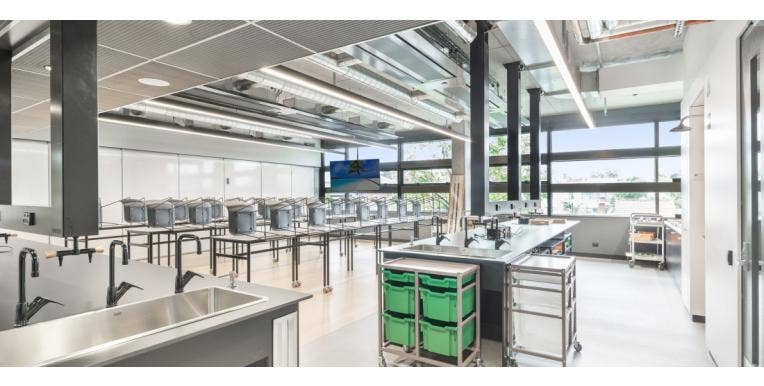Top 6 Laboratory Design Trends
1. More open-design, teamwork orientated labs
With the evolution of education etc., teamwork and ‘see and be seen’ working cultures are on the rise.
More open space, visibility and flexibility means that there is fewer individual workstations and private offices, and more collaborative space. This is an progressively used design in universities, STEM orientated schools and dedicated laboratories which enables increased collaboration, safety and teamwork; and means learning and researching is embraced.
Many labs are also configurable and adaptable to suit the kind of activities undertaken, meaning one area can be dedicated to a particular area of study.


Wycheproof College is an open-design lab promoting teamwork and collaboration.
2. More digitised & automated labs
Labs are becoming more computerised. Robotics used more and more for difficult and precise tasks, and computers doing very complex arithmetic to achieve what scientists can’t. In addition, cloud technology enables remote access to complex equipment and running info on processes, and is being used more in labs to store data, processes, cycles, lab procedures etc.
Automation can also complete complex and sometimes slow, monotonous tasks in short spaces of time for greater efficiency and accuracy. Although laboratory automation was very costly previously, it is now becoming a more accessible and affordable commodity, therefore common. The first fully automated laboratory being opened in the 1980s by Dr Masahide Sasaki, while costing millions, proved an undeniable success.
Automation has become very popular due to the lower costs available these days and is proving very successful.
3. Innovative & compact equipment
Compact equipment means more items on your shelves, more room for work, and less need for storage space. This allows lab processes to become more efficient, by using less of the fluids or chemicals to produce a result.
This cost-effective solution, therefore, improves the ppe lab productivity. As well as being small and lightweight, a majority of lab equipment is becoming modular and configurable, e.g. universal test-tube racks,; as opposed to five different test tube rack dimensions and tube sizes. One-size-fits-all silicone stoppers, with ‘pluggable’ holes for any type of experiment.
These types of innovations are what save laboratories money, time and effort while improving productivity.
4. Sustainability-focused design
How to design a laboratory layout is becoming more focused on maximising sustainability. This includes making use of natural light, reducing carbon footprint; recycling and investing in more efficient equipment, conserving energy and water, and reducing the amount of hazardous or toxic chemicals that potentially harm the environment.
This helps to lessen the substantial amounts of energy that are typically used up by laboratories, that usually require UPS (Uninterrupted Power Supply), large backup systems, 24-hour access, and large amounts of heat-generating, containment and exhaust systems that require huge amounts of energy.
Another contributor to lab energy use is the need for clean, unrecycled air. Of late, lab trends are proving to show that sustainability is key, so that design elements contribute to maximum efficiency, and so the impact on the environment is minimised.


Monash University, Biomedical Laboratory
5. Use of a third dimension
Scientists are using three dimensions increasingly in various ways, which open up pathways to research and learning. 3-Dimensional printing, modelling and imaging for research and education is proving to be the way ahead. Scientists have printed functioning, living liver cells which lived for up to 40 hours.
One example of one of these labs is the Swedish start-up Cellink, who now produce small parts of tissue with 3-D printing. Predictions are that within the decade we may even be able to print fully functioning, replacement organs. 3-D modelling, on the other hand, is enabling scientists to gain a greater understanding of what they are studying. This provides graphic, highly detailed imaging to provide an immersive experience, giving the scientist a greater understanding of the thing being studied.
3-D mapping also affords unique capabilities by opening up another spectrum of study—being able to store data in the form of a near-tangible model. This provides perspective and the ability to store very accurate graphic data.
6. Greater lab flexibility
Now that the world of study is all blurred into one big study, laboratories are not now being designed as per function, rather than an area of study. For example, rather than a lab dedicated strictly to pathology, its function may cater to pathology, oncology and cardiology.
This allows for very efficient and productive lab use, meaning you don’t have to build one for each department. With sustainable design, these labs are now becoming increasingly efficient and productive, saving the lab money, and proving effective in these fields where one study links to another.
These labs are also opening the way for the medical world where results from one study can be linked with another, for example, thus bringing your labour to fruition quicker.


Wyndham Tech School provides excellent flexibility in-room functions.


